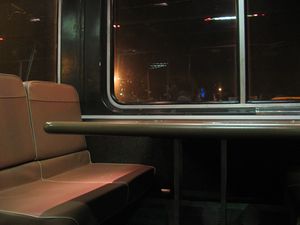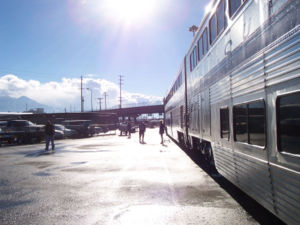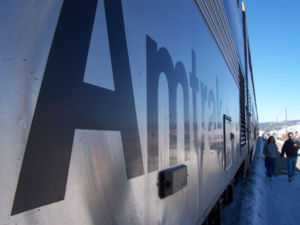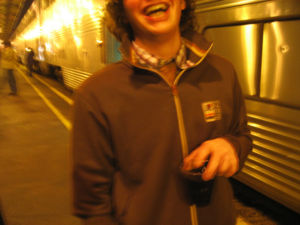California Zephyr
The California Zephyr is a 2,438-mile Amtrak route operating between Chicago, Illinois, and Emeryville, California (near San Francisco). Knox students usually use it for its service to Chicago, which is scheduled to depart daily at 12:10 PM but actually departs several hours later, making many students miss their flights. Besides this route, it runs through Illinois, Iowa, Nebraska, Colorado, Utah, Nevada, and California. Most of the trackage is owned by Union Pacific.
Contents
Scenery[edit]
The California Zephyr is considered among the most scenic Amtrak routes. From Emeryville, it runs along the edge of San Francisco and San Pablo bays and across the Carquinez Strait, then into the Coast Range and out across the Central Valley, through Sacramento and the Roseville rail yards (the largest west of the Mississippi), and from there up into the Sierra Nevada mountains, emerging at Reno. From there, it continues to roughly follow Interstate 80 through Nevada to Salt Lake City, where it dips south through Utah. In Colorado it follows Interstate 70 through the Glenwood Canyon and descends from the Rockies at Denver. From there it runs through eastern Colorado and Nebraska to Omaha, and crosses the Mississippi River at Burlington, Iowa. Galesburg comes soon after, and then the train heads for Naperville and Chicago.
If you're heading west, the order is reversed.
The scenery is best viewed from the north side of the train.
Accommodations[edit]

Most Knox students stay in the coach cars, of which there are three (this is only the case during on peak travel seasons when the train is sold out,most other times during off peak travel seasons there are two coaches.), located on the rear end of the train. Almost all seating is on the upper level (lower level seating is for disabled persons). The lower level also contains luggage storage and bathrooms. There is one bathroom on each car where, behind the diaper-changing table, one can use a coin to turn a screw and then fiddle with the car number.
When the train is at all crowded, the train attendants assign seats. Otherwise the seating is usually open. A placeholder slip stuck on the luggage rack claims the seat for you when you are not in it.
Brian Conley once slept in a sleeping car on the Southwest Chief, which has similar accommodations. They are triple the cost (or more) but have more privacy and beds.
The chairs offer a lot of legroom, and the seats can be leaned back and a footrest propped up for sleeping. Sleeping is very uncomfortable, although it is much improved if you have a two-seat row to yourself. Generally, conditions are much less cramped and more comfortable than airplane travel
The windows have a lot of glare.
Most Knox students, taking the train to and from Denver or points east, often share seats. Those who get on or are going further west will have a whole row for much of the trip.
In front of the coach cars there is a lounge car, with cramped seating arrangements on the upper level (these are popular with people who have seatmates they don't know) and a snack bar with seating booths on the lower level. The snack bar serves food including hot dogs, hamburgers, personal pizzas, chips, hot wings, candy, cookies, sodas, and airplane-sized bottles of alcohol. The alcohol laws of whatever state the train is in are followed. The food is expensive, and is tolerably good, but after two days one's stomach might feel a little queasy. The snack bar is open from 6 AM to 11 PM. After 11 PM, the lower level is a good place to socialize, drink, and play music without bothering anybody else.
In front of that there is the dining car, with serves breakfast, lunch, and dinner. The food is better, with waited tables and so on, but dinner runs about $15-20 per person. A train attendant comes through the train asking for reservations for lunch and dinner, but he goes to the sleeping cars first. It is best to make reservations with parties of at least three people when the train is at all crowded, because otherwise the porters will seat smaller parties together at the same table, leading to awkward conversation.
There is a fruit stand and small convenience store in the station at Grand Junction, Colorado.
The climate within the trains is generally quite dry. It is best to stock up on water or other beverages for overnight travel.
There is no smoking allowed on the trains. Every few hours the train stops long enough for passengers to smoke a cigarette. These stops are not particularly regular and are based on adherence to the closest thing they can muster to a schedule, so cigarette smokers must be prepared. Sometimes during extended delays where the train is standing still for hours (see Notable Trips below), train attendants will allow extra-nice passengers to smoke in the vestibule between cars. The train also makes more extended stops in Salt Lake City, Denver, and Omaha.
The cars were built several decades ago, so there are very few electrical outlets. Generally there is one located near the center of each coach car, in a seat row. The lounge car has two plugs on the upper level and three or four more plugs on the lower level. Sometimes one is forbidden from using the outlets on the lower level, but nobody will check after the snack bar is closed.
Staff and fellow passengers[edit]
California Zephyr riders are a curious bunch. They come from various walks of life, although they are rarely in a hurry, given the train's schedule issues. Many people who are unfamiliar with the train complain a lot, generally during cigarette breaks.
A large number of Knox students use the California Zephyr, generally for travel between Knox and points west. Most experienced Knox students know not to use the California Zephyr for eastbound travel to Chicago (see Schedule below).
Other notable types of passengers include the Amish. They are distinguished through their clothing, large number of well-behaved children, and use of German.
Schedule[edit]

The trains, numbered 5 (westbound) and 6 (eastbound), depart once per day.
Published Schedule[edit]
The published schedule is located here.
Major Knox student-frequented stops and their schedules (in local time) include:
| City | Westbound train departs | Eastbound train departs |
| Chicago | 1:50 PM | 3:30 PM (end) |
| Naperville | 2:24 PM | 1:47 PM |
| Galesburg | 4:28 PM | 11:44 AM |
| Omaha | 10:39 PM | 5:44 AM |
| Denver | 8:05 AM | 7:25 PM |
| Salt Lake City | 11:59 PM | 3:45 AM |
| Reno | 9:14 AM | 3:58 PM |
| Sacramento | 2:15 PM | 11:14 AM |
| Emeryville | 4:49 PM | 9:15 AM |
Actual Schedule[edit]
The published schedule is almost always wrong. The train generally leaves on time from Chicago and Emeryville, if there are no major expected delays. The train reliably loses three hours in Nevada, generally standing still while everybody is asleep to allow freight trains to pass.
The standard delay for arriving at a final destination ranges from 3-7 hours. Anything beyond that constitutes a major delay, generally caused by a service disruption.
Union Pacific is often responsible for the regular delays. They are required by law and by the contracts they have signed with Amtrak to give passenger trains first priority, but the law is not well-enforced, and so Union Pacific assigns Amtrak last priority, especially when determining which trains to run first after a service disruption. Also, much of the Union Pacific trackage is in poor condition, and there are numerous speed restrictions on parts of it. For most Knox students this is only a major problem going eastbound, for the worst of the track, and the slowest speeds, are west of Denver.
When expecting the California Zephyr, one should never bother leaving for the train station until after checking at least the Amtrak website. Sometimes the website is not updated in a timely fashion (especially during major delays), in which case it's better to call 1-800-USA-RAIL for train status information.
Notable Trips[edit]
- The eastbound train leaving Emeryville on 31 December 2004 (to arrive in Galesburg on 2 January) was stuck in the Sierra Nevadas for several extra hours due to a breakdown in deicing equipment on a single-track pass in Emigrant Gap. At one point the train stood still for two hours. The smokers almost rioted. The train ran approximately seven hours late for the remainder of the eastbound journey.
- The eastbound train leaving Emeryville on 31 December 2005 (to arrive in Galesburg on 2 January) was canceled after a landslide blocked the track along San Pablo Bay in California. Students had to arrange alternate transportation. Kelli Refer and Sam Gagnard left for Galesburg one day early, Danny Fisher-Bruns and Alex Nimmer took a bus to Raton, New Mexico, to pick up the Southwest Chief, and Geoff Brown drove to La Junta, Colorado, to do the same. Brian Camozzi, faced with the prospect of an expensive last-minute flight to Chicago, flew to Los Angeles instead to pick up the Southwest Chief as well.
- The earliest California Zephyr train on record left Roseville, California on 18 March 2007, going eastbound. During Spring Break 2007 a 90-year-old railroad trestle in Sacramento (just west of Roseville) that was part of Union Pacific's mainline trackage burned to the ground, likely due to arson. The California Zephyr was canceled for several days, but resumed on 18 March beginning in Roseville with bus service to Emeryville. Because it started in Roseville on time, and because all freight trains from San Francisco were diverted two hours north to Marysville, the train did not use a substantial amount of time in Nevada, and arrived in Denver only 1 hour and 45 minutes late and in Galesburg 1 hour late. Brian Camozzi, due to a poorly planned flight from Sacramento to Denver, almost missed it.
Knox Passengers[edit]
This is a partial list of common Knox travelers on the California Zephyr.
- Coming from Omaha: Pat Cogar
- Coming from Denver: Geoff Brown, Danny Fisher-Bruns, Alex Nimmer, Devon VaughnMiller, Sam Gagnard, Matt Allis, Kelli Refer, Matt Hundley
- Coming from Sacramento: Brian Camozzi
Gallery[edit]
NOTE: Images are in order from west to east.
The Carquinez Straits near San Francisco Bay
Roseville, California, near Sacramento
Sierra Nevada mountains in eastern California
Sunrise in eastern Nevada
Amtrak station in Salt Lake City
Provo, Utah
Eastern Utah
Eastern Utah
Western Colorado
Glenwood Springs, Colorado
I-70 in Colorado
Fraser-Winter Park, Colorado
Denver as seen from the Rocky Mountains
Rural Nebraska
Omaha, Nebraska
See also[edit]
- Amtrak
- Southwest Chief
- Union Pacific
- Burlington Northern Santa Fe
- Illinois Zephyr
- Carl Sandburg (train)
























